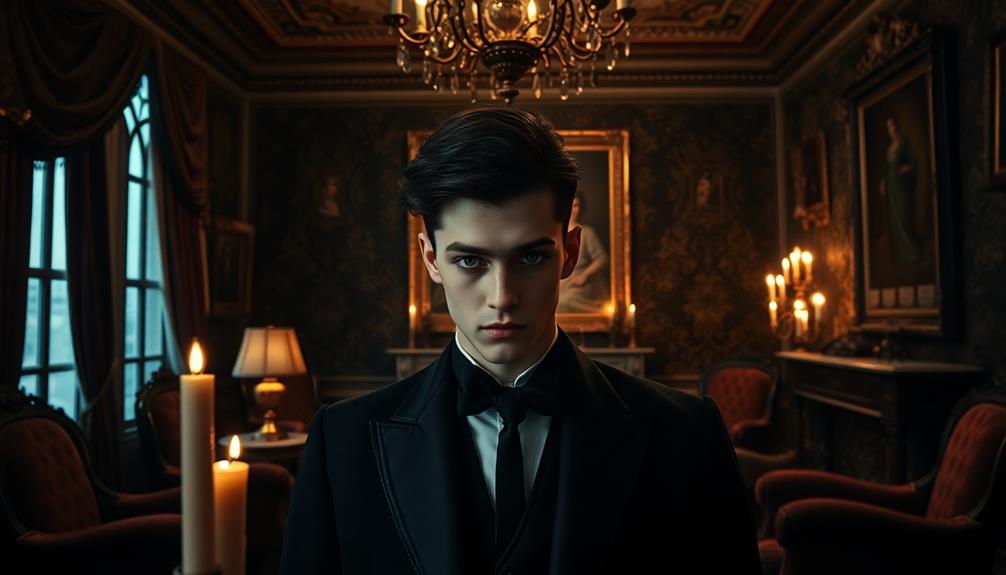Oscar Wilde's "The Picture of Dorian Gray" challenges you to contemplate beauty's deeper implications within society. Characters like Dorian, Basil, and Lord Henry personify the struggle between innocence and moral decay. Through Dorian's tale, you witness the dangers of hedonism and the conflict between aestheticism and ethical values. Wilde sheds light on how societal expectations shape individual desires, making you question your own values. The portrait symbolizes this inner turmoil, serving as a haunting reminder of your choices. Explore how Wilde's insights reflect both personal and societal struggles, revealing layers you might not have expected.
Historical Context of the Novel
"The Picture of Dorian Gray," published in 1890, emerged during a time when Victorian society upheld strict moral codes alongside a growing fascination with aestheticism. This novel, with its exploration of Dorian Gray's descent into hedonism and moral corruption, scandalized a society that valued restraint and decorum.
While people sought beauty and pleasure, they also grappled with the consequences of indulgence, much like the struggles depicted in Louis Zamperini's survival story against extreme adversity in "Unbroken."
Wilde's narrative reflects the tensions between individual desires and societal expectations, illustrating how Dorian's pursuit of aestheticism leads to his ultimate downfall. The Victorian era was marked by rigid moral standards, where exploring sexuality and personal freedom often faced backlash.
Wilde himself faced severe repercussions for his views and lifestyle, as the themes in his work became evidence against him in his infamous trial in 1895.
This historical context enriches your understanding of the novel, highlighting its significance in discussions about morality and identity. By examining the societal pressures surrounding Dorian, you can appreciate how Wilde's work challenges the norms of his time, making "The Picture of Dorian Gray" a timeless exploration of the conflict between art, morality, and the self.
Overview of Key Characters
In "The Picture of Dorian Gray," you'll encounter Dorian's duality, where his outward beauty masks a soul in turmoil. This conflict mirrors the themes found in other literary works, such as the exploration of personal growth and resilience seen in David Copperfield.
Basil Hallward's obsession with Dorian highlights the emotional intensity of their relationship, while Lord Henry's cynical influence pushes Dorian further into a life of hedonism.
Together, these characters create a rich tapestry that explores the themes of art, morality, and the consequences of choice.
Dorian Gray's Duality
Duality defines the characters in Oscar Wilde's "The Picture of Dorian Gray," revealing the contrasts between innocence and corruption, art and obsession. At the center is Dorian Gray, whose striking beauty initially captivates everyone around him. However, as he succumbs to the hedonistic philosophy espoused by Lord Henry Wotton, Dorian's pursuit of pleasure leads him down a dark path of moral decay. His transformation highlights the struggle between surface allure and inner emptiness.
Basil Hallward, the artist, embodies the tension between admiration and vulnerability. He sees Dorian as the epitome of beauty, becoming infatuated with him. This infatuation brings forth Basil's emotional attachment, contrasting with Lord Henry's detached cynicism.
While Basil represents the integrity of art, Lord Henry fuels Dorian's obsession with aestheticism, pushing him further into a world devoid of morality.
The presence of Sibyl Vane, with her tragic innocence, and her brother James Vane, who seeks vengeance, further accentuates Dorian's duality. These characters illuminate the consequences of Dorian's choices, emphasizing the profound impact of his descent into vice on those around him.
Basil Hallward's Obsession
Basil Hallward's infatuation with Dorian Gray serves as a pivotal aspect of the narrative, showcasing the complex interplay between admiration and obsession. As the artist who captures Dorian's beauty in his portrait, Basil becomes deeply emotionally attached, viewing Dorian as an essential muse for his creative expression. This attachment complicates their relationship, as Basil grapples with profound feelings of admiration entwined with pain.
His obsession leads him to fear the public display of the portrait; he worries that it might expose his vulnerabilities and the depth of his feelings for Dorian.
Basil Hallward stands out for his moral integrity, contrasting sharply with the hedonistic views of Lord Henry Wotton. Basil believes in the inherent goodness of relationships, which makes his emotional turmoil all the more poignant.
The dynamics between Basil and Dorian illustrate a tension between artistic creation and personal sacrifice. As Basil idealizes Dorian, this obsession ultimately culminates in a tragic confrontation over Dorian's moral decline.
Through Basil, Wilde explores the dangers of allowing admiration to morph into an all-consuming obsession, highlighting the fragile boundary between inspiration and possessiveness.
Lord Henry's Cynical Influence
Lord Henry Wotton stands as a magnetic force in "The Picture of Dorian Gray," shaping Dorian's journey through his hedonistic philosophy. With his charismatic charm, Lord Henry introduces Dorian to a world where beauty and pleasure reign supreme. His cynical perspective on society encourages Dorian to abandon moral constraints and embrace a life of indulgence.
Consider the impact of Lord Henry's influence:
- He promotes the idea that beauty is the only thing worth pursuing.
- His critiques of societal norms provoke Dorian's curiosity and rebellion.
- Lord Henry's manipulation distorts Dorian's views on love and self-worth.
- He embodies the allure of a life free from guilt and restraint.
- His philosophy ultimately leads Dorian down a path of moral decay.
As you see Dorian transform, you can feel the tension between innocence and corruption.
Lord Henry's cynical influence drives home the peril of unchecked desires, illustrating how one person's ideology can profoundly reshape another's character.
In the end, his pursuit of beauty comes at a steep price, leading Dorian to confront the dark consequences of a life lived without ethical boundaries.
Themes of Aestheticism and Morality
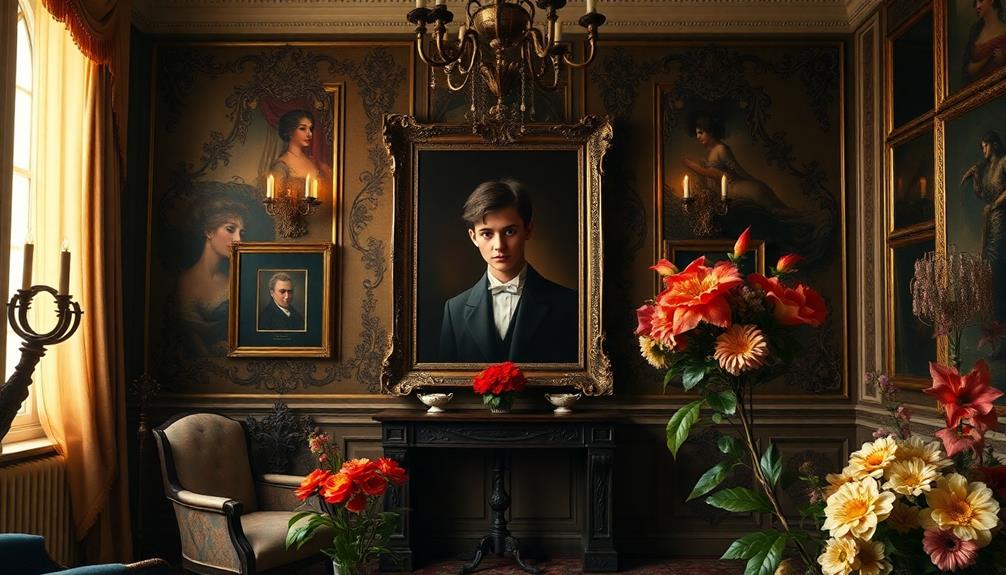
In "The Picture of Dorian Gray," you see the clash between aestheticism and morality as Dorian's pursuit of beauty leads him down a dark path.
The allure of hedonism tempts him, much like the themes of collective wrongdoing and consequences of sin found in the concept of the scapegoat, but the consequences of his choices reveal the dangers of valuing pleasure above all else.
This tension raises important questions about the true cost of a life devoted solely to aesthetic enjoyment.
Aestheticism's Moral Dilemma
Aestheticism presents a compelling moral dilemma, especially in Oscar Wilde's "The Picture of Dorian Gray." By elevating beauty and sensory experience above ethical considerations, Wilde challenges readers to question the consequences of pursuing pleasure without accountability.
You see this conflict vividly in Dorian's journey, where the relentless pursuit of beauty leads to his moral degradation.
Consider the following emotional stakes:
- The allure of beauty can blind you to ethical truths.
- Indulgence may feel liberating but often carries hidden costs.
- A life without moral compass can lead to profound loneliness.
- The mask of charm often hides a decaying soul.
- The pursuit of beauty can trap you in a cycle of despair.
Wilde critiques societal hypocrisy, showing how the wealthy preach morality while living in contradiction.
Lord Henry embodies hedonism, enticing Dorian to abandon his values. The portrait serves as a haunting reminder of Dorian's internal decay, emphasizing how aestheticism, when devoid of morality, can corrupt the soul.
Ultimately, Wilde's exploration of aestheticism invites you to reflect on the delicate balance between beauty and ethical responsibility.
Consequences of Hedonism
How does the pursuit of pleasure shape our moral landscape? In "The Picture of Dorian Gray," Oscar Wilde vividly illustrates the consequences of hedonism through Dorian's downfall. Initially enchanted by beauty and sensory indulgence, you witness Dorian's transformation as he prioritizes fleeting pleasures over moral integrity. This relentless chase leads to his profound isolation and despair, highlighting the stark reality of moral decay.
Influenced by Lord Henry's philosophy of aestheticism, Dorian's obsession with eternal youth blinds him to the repercussions of his actions. Each moment of indulgence comes at a cost, as he neglects the impact on those around him. The tragic fate of Sibyl Vane serves as a poignant reminder of this collateral damage. Her innocence, crushed by Dorian's selfish desires, underscores the destructive nature of his pursuits.
Wilde critiques the societal norms of the Victorian era, showing how embracing hedonism without accountability leads to devastating consequences. Ultimately, Dorian's journey reveals that the allure of beauty and pleasure can corrupt the soul, leaving you to ponder the fragile balance between aesthetic enjoyment and moral responsibility.
The Role of Art in Society
Amid the vibrant canvas of society, art emerges as a powerful mirror reflecting both its beauty and its moral complexities. In "The Picture of Dorian Gray," Oscar Wilde critiques the superficiality of Victorian values, suggesting that art isn't just an imitation of life but a revelation of deeper truths. It exposes societal morals and challenges you to confront your own beliefs.
As you engage with art, consider how it can lead to mindfulness and self-reflection, enhancing your understanding of personal values and choices.
Consider how art can evoke profound emotions:
- It can illuminate the struggle between beauty and morality.
- It can reveal the hypocrisy lurking beneath societal norms.
- It can inspire personal reflection on your own choices.
- It can challenge you to question the nature of aestheticism.
- It can remind you that the pursuit of beauty can lead to moral decay.
Wilde believed that art should allow for personal engagement, making you ponder the subjective nature of beauty.
Through Basil Hallward's attachment to Dorian, Wilde emphasizes the tension between artistic integrity and societal expectations.
Ultimately, art holds power, urging you to reflect on your values and the moral dilemmas woven into the fabric of society.
Dorian Gray's Character Arc
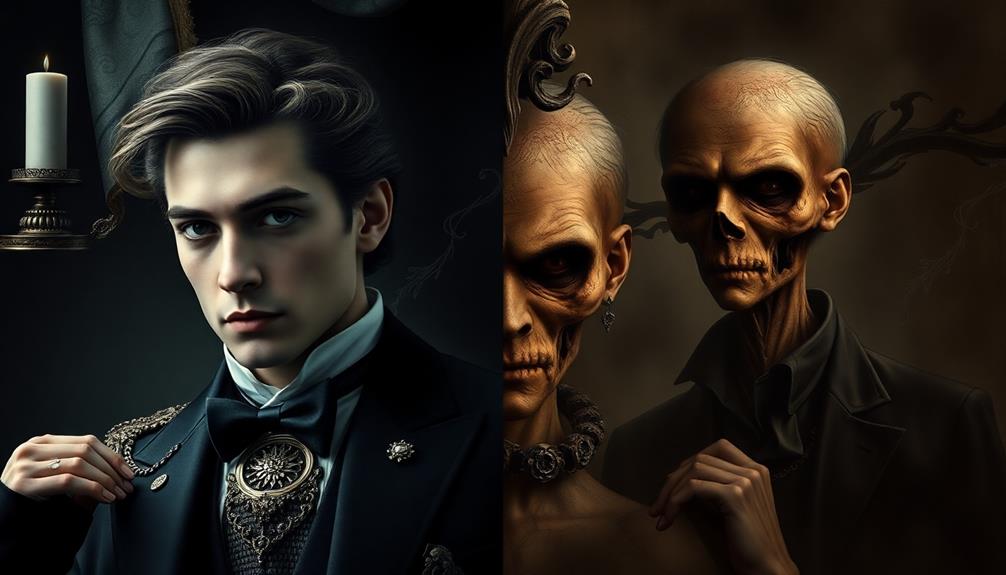
Dorian Gray's character arc is an enthralling journey from innocence to moral decay, highlighting the dangers of unchecked hedonism. Initially, you see Dorian as a charming young man, captivated by the alluring philosophies of aestheticism championed by Lord Henry Wotton. His engagement to the innocent Sibyl Vane marks a pivotal moment; her tragic death awakens a deep-seated desire for indulgence, plunging him into moral corruption.
This transformation echoes themes of disillusionment, similar to those found in suburban disillusionment explored in Richard Yates' work. As you follow Dorian's descent, his obsession with preserving beauty leads him to commit unspeakable acts, including the murder of Basil Hallward, the artist who dared confront him about the state of his portrait.
This horrific act symbolizes Dorian's complete decline, as he realizes that his eternal youth is paired with a soulless existence. Throughout the narrative, Dorian grapples with his identity, confronting the superficiality of his beauty against the backdrop of his increasingly tainted soul.
Ultimately, in a desperate attempt at redemption, he destroys the portrait, only to meet his own demise. This final act illustrates the inescapable consequences of a life devoted to aestheticism and the neglect of moral integrity.
Influence of Lord Henry Wotton
Few characters in literature wield as much influence over another as Lord Henry Wotton does over Dorian Gray in Oscar Wilde's novel. Through his charm and persuasive rhetoric, Lord Henry introduces Dorian to hedonism, enticing him to prioritize beauty and sensual pleasures above all else.
This seductive philosophy becomes a catalyst for Dorian's transformation, steering him away from innocence and into a world of moral decay. Much like the haunting atmosphere of Manderley in *Rebecca*, Lord Henry's influence conceals deeper psychological complexities that resonate throughout Dorian's journey, revealing the dark undercurrents of desire and fear that shape his identity the psychological turmoil of characters.
As you explore this dynamic, consider the impact of Lord Henry's influence:
- He challenges Dorian's views on morality and virtue.
- He promotes a lifestyle focused on indulgence and self-gratification.
- He embodies the allure of aestheticism, elevating beauty to a dangerous pedestal.
- He manipulates Dorian's desires, transforming him into a self-centered figure.
- He ultimately leads Dorian down a path of existential despair.
Through Lord Henry Wotton, Wilde illustrates the peril of charismatic influence, showing how a single person's ideology can reshape another's life. Dorian's eventual downfall serves as a cautionary tale about the seductive power of hedonism and the consequences of abandoning moral integrity.
Symbolism of the Portrait
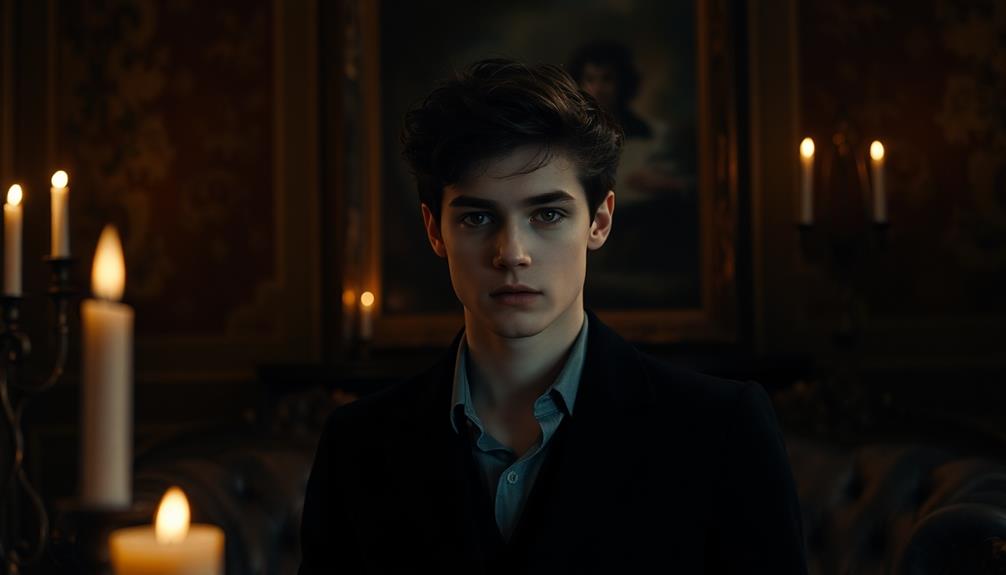
The portrait of Dorian Gray symbolizes the stark contrast between outward beauty and inner corruption. As you explore the story, you see how the portrait reflects Dorian's moral decay while he indulges in a hedonistic lifestyle.
Initially, the painting is a stunning work of art, representing Dorian's youthful allure. However, as he descends deeper into vice, the portrait becomes grotesque, mirroring the consequences of his choices. This transformation echoes the allure of dark academia seen in works like *The Secret History*, where the pursuit of forbidden knowledge often leads to moral ambiguity and devastating outcomes the allure of dark academia.
This transformation emphasizes the theme of duality, showcasing Dorian's pristine exterior alongside the hidden reality of his actions. You can't help but notice how Dorian's obsession with the portrait breeds guilt and paranoia. Each glance at the painting serves as a painful reminder of his lost innocence and the degradation of his soul.
Ultimately, the portrait encapsulates the dangers of a life dedicated solely to aestheticism. It highlights the moral implications of pursuing beauty at the expense of one's integrity.
As you read, you realize that the portrait isn't just a reflection of Dorian's physical self but a haunting reminder of the inevitable consequences of his choices.
Wilde's Philosophical Insights
Wilde's philosophical insights challenge your views on art and morality, urging you to appreciate beauty for its own sake. He argues that art shouldn't be burdened by moral judgments but instead should reflect the duality of human nature.
This perspective resonates with Aldous Huxley's critique of societal control and the complexities of individuality, as seen in the dangers of technological advancement.
As you explore these ideas in "The Picture of Dorian Gray," you'll uncover how aestheticism plays a vital role in understanding the characters and their choices.
Aestheticism and Morality
Oscar Wilde's philosophy of aestheticism challenges conventional notions of morality in art, arguing that beauty and sensory experience should take precedence over ethical considerations. He asserts that there are no moral or immoral books, only well or poorly written ones.
In "The Picture of Dorian Gray," Wilde critiques the hypocrisy of Victorian society, where characters preach moral values while indulging in vice. This tension reveals the complex relationship between aestheticism and moral life.
Consider these emotional reflections:
- The allure of beauty can lead to dangerous desires.
- Society's moral facade often hides true intentions.
- The pursuit of pleasure can spiral into despair.
- Art's integrity might flourish in the absence of ethical constraints.
- Aesthetic experiences can be both uplifting and devastating.
Wilde suggests that the moral life of an artist influences their work, yet he believes that ethical sympathies can hinder creativity.
The novel illustrates the consequences of hedonism, showing that beauty and artistic integrity can coexist with a disregard for conventional moral standards—challenging you to rethink the relationship between aesthetics and ethics in your own life.
Duality of Human Nature
Amidst the seductive allure of beauty and pleasure, "The Picture of Dorian Gray" reveals a profound exploration of the duality of human nature. You see Dorian's transformation from an innocent youth to a morally corrupt individual, highlighting the conflict between his inner desires and societal expectations. Wilde suggests that the pursuit of beauty can lead to self-destruction, as Dorian's choices sever him from his own humanity.
The stark contrast between Dorian's external beauty and the decaying portrait symbolizes this disparity between outward appearances and inner reality. This notion emphasizes the complexity of human identity, where moral decline often lurks beneath the surface.
Lord Henry Wotton's hedonistic philosophy acts as a catalyst for Dorian's corruption, illustrating how external influences can distort one's innate character and lead to a fragmented self.
Wilde's portrayal of characters like Basil Hallward and Lord Henry underscores the tension between artistic integrity and the allure of aestheticism. This tension reveals the inherent struggle within human nature, as you witness the constant battle between virtue and vice.
Ultimately, Wilde invites you to reflect on the consequences of these dualities in your own life.
Reception and Controversy
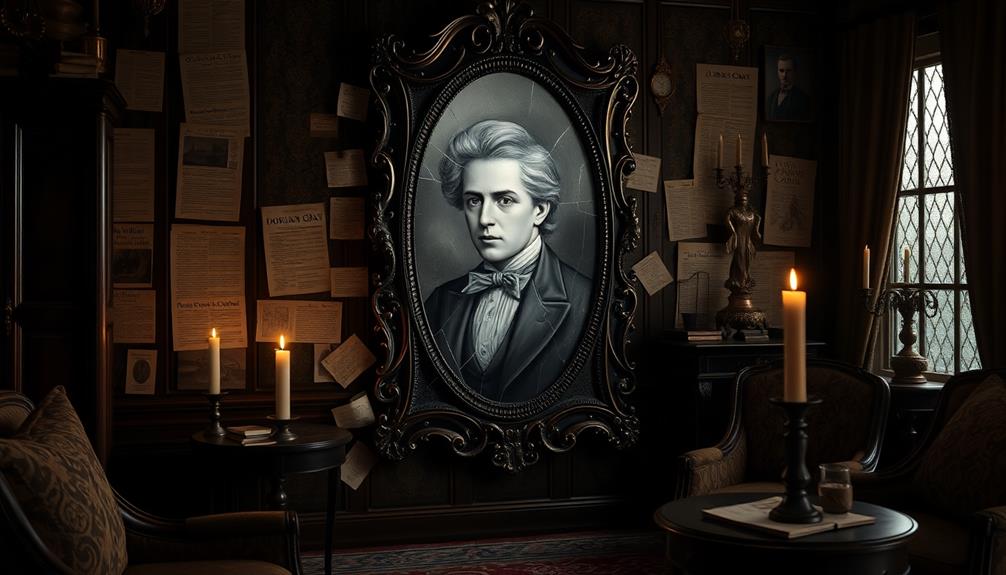
The reception of "The Picture of Dorian Gray" was nothing short of tumultuous, igniting fierce debates across Victorian society. From its publication in 1890, the novel scandalized readers with its bold themes of aestheticism, hedonism, and moral corruption. Critics denounced the book, labeling it immoral and sparking passionate discussions about art's ethical implications.
You might feel the weight of this controversy reflected in:
- A society grappling with its rigid moral codes
- The clash between artistic freedom and societal expectations
- The fear of losing innocence to hedonistic pursuits
- The challenge to authority posed by Wilde's ideas
- The haunting echo of Wilde's trial, where the novel became a weapon against him
Wilde defended his creation, asserting that there are no moral or immoral books, only well-written or poorly written ones. This stance highlighted the importance of literary quality over ethical judgment.
Ironically, the controversy surrounding "The Picture of Dorian Gray" not only cemented its status as a classic but also propelled discussions on individual rights and societal norms, making it a pivotal work in the Gothic genre.
Legacy in Literature and Culture
Wilde's bold challenge to Victorian norms in "The Picture of Dorian Gray" left a lasting mark on literature and culture, shaping how we view art and morality. This pivotal work in Gothic literature explores themes of aestheticism and moral corruption, igniting discussions that resonate even today.
Wilde's assertion that "there are no moral or immoral books, only well or poorly written ones" continues to spark debates among literary critics, delving into the intricate relationship between art, ethics, and societal values.
The novel's provocative themes have inspired various adaptations, including a notable 1945 film that garnered three Academy Award nominations. These adaptations keep Wilde's legacy alive, demonstrating how his exploration of beauty and hedonism remains relevant in contemporary discussions about identity and self-indulgence.
Additionally, "The Picture of Dorian Gray" serves as a lens through which you can examine societal attitudes toward sexuality and individuality in the late 19th century.
As you engage with this text, consider how Wilde's work challenges you to reflect on your own views about morality in art, ensuring that his legacy continues to influence modern literature and cultural discourse.
Conclusion
In the grand tapestry of literature, "The Picture of Dorian Gray" stands as a mirror reflecting the duality of human nature. Like a chameleon, Dorian shifts from innocence to corruption, reminding you that beauty can mask darkness. Wilde's brush strokes create a vivid portrait of society's moral dilemmas, urging you to ponder the price of vanity. As you close this chapter, remember: every soul carries a portrait, and it's the choices you make that shape its colors.

